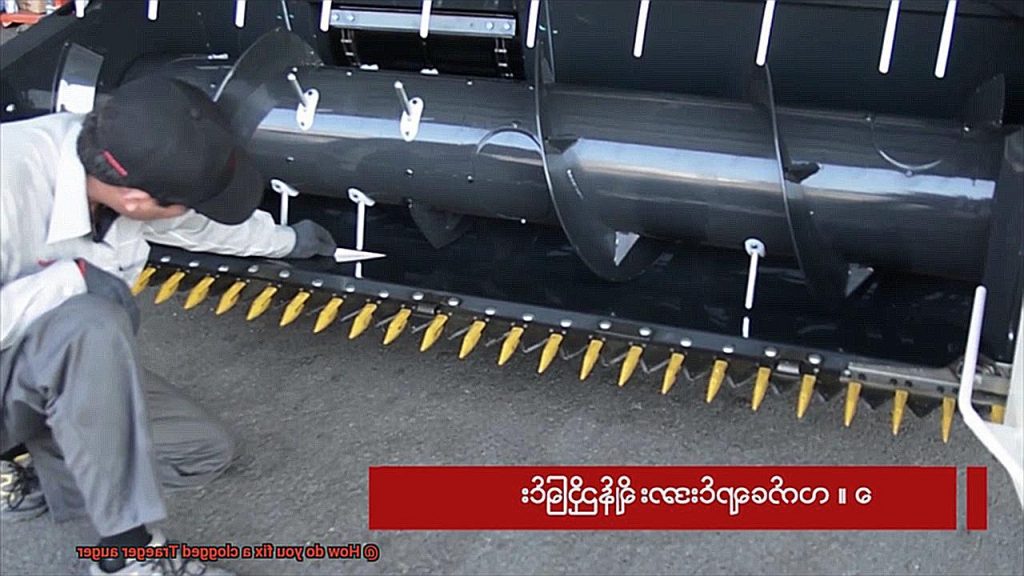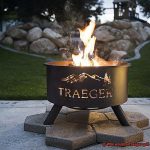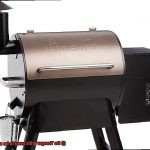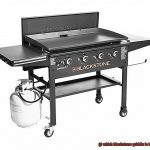Are you a Traeger grill enthusiast who loves the convenience of using a pellet grill? Nothing beats the smoky flavor and consistent heat it provides, without the hassle of traditional charcoal or gas grills. But like any grill, maintenance issues can arise from time to time. One of the most common problems Traeger users face is a clogged auger.
A clogged Traeger auger can be frustrating, leading to uneven cooking and even grill malfunctions. Fear not, fixing a clogged auger is easier than you might think. In this blog post, we’ll provide you with a step-by-step guide on how to fix it yourself. Plus, we’ll share tips for avoiding clogs in the first place.
Before we dive into the solution, let’s take a moment to understand what causes the Traeger auger to clog. Food debris, dirt, and moisture are the primary culprits that accumulate in the auger over time and restrict pellet flow. But don’t worry; with some basic knowledge and simple tools on hand, you’ll be able to keep your Traeger running smoothly. So let’s get started.
Contents
What is a Traeger Pellet Grill?
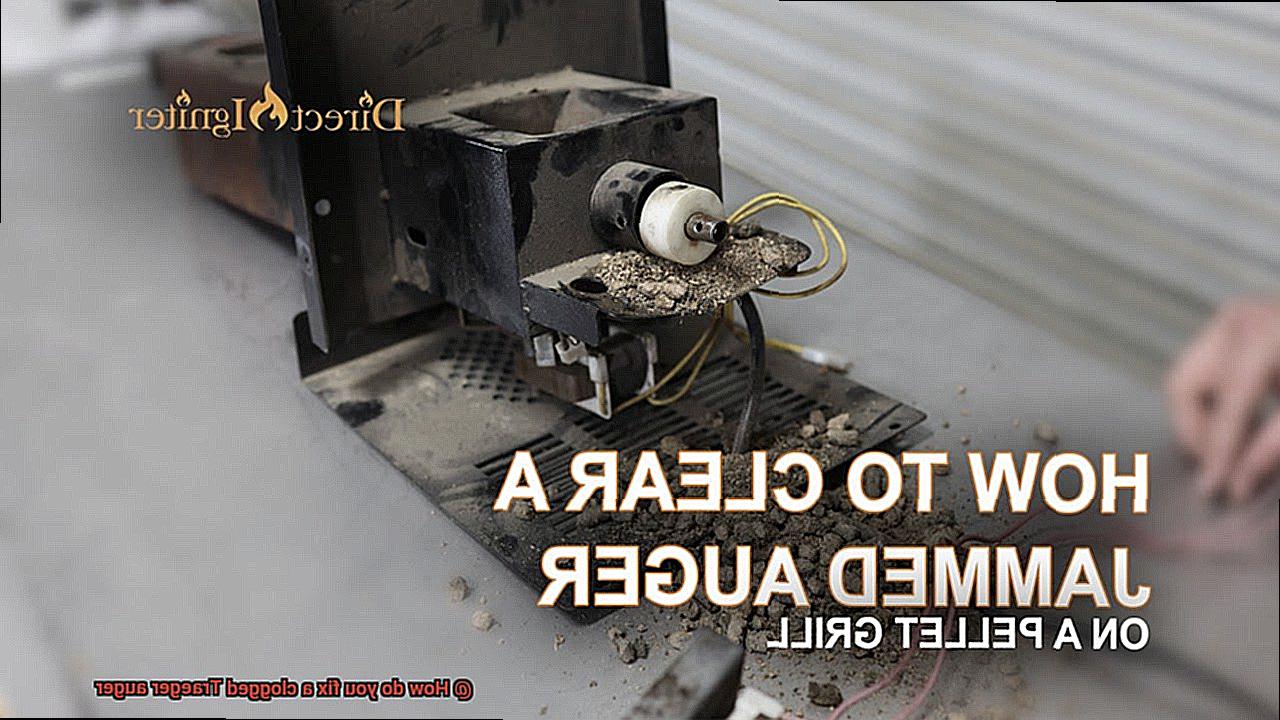
If you’re looking for a unique and enjoyable outdoor cooking experience, consider a Traeger Pellet Grill. These grills use wood pellets as fuel and were first invented in the mid-1980s. Since then, they have become a popular alternative to traditional gas or charcoal grills.
One of the most significant advantages of a Traeger Pellet Grill is its automated system, which controls the temperature and smoke level for consistent and even cooking. The process begins by filling the hopper with wood pellets, which are then fed into the auger. The auger is a long, spiral-shaped rod that rotates and moves the pellets from the hopper to the firepot. Once in the firepot, the pellets are ignited and burned, producing heat and smoke that cook your food to perfection.
With precise temperature control and the unique smoky flavor imparted by wood pellets, Traeger Pellet Grills are perfect for cooking anything from burgers to brisket to vegetables. Additionally, they offer a wide range of temperatures, allowing for precise cooking control. This means that you can cook your food at exactly the right temperature every time.
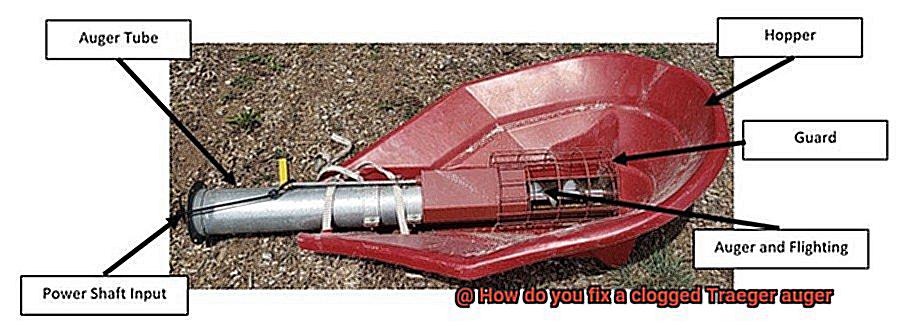
However, like any grill, issues can arise with Traeger Pellet Grills. One common issue is a clogged auger, which can be frustrating but easily fixed. If this happens, turn off the grill and unplug it from the power source. Open up the hopper lid and remove any pellets that are still in there. Remove the grates and heat diffuser plate to access the auger. Use a long, thin object to remove any debris stuck in it. If that doesn’t work, disassemble it to get everything out or call in a professional.
What is an Auger and Why Does it Get Clogged?
This device is responsible for delivering wood pellets from the hopper to the firepot, creating the perfect cooking environment for your outdoor meals. However, when the auger gets clogged, it can quickly turn your grilling experience into a frustrating one. So, what exactly is an auger, and why does it get clogged?
Picture a long, spiral-shaped screw that rotates to push pellets through a tube and into the fire – that’s an auger. It’s a vital component of your grill, and when it gets clogged, it can cause uneven heating, reduced smoke production and eventually shut down your grill.
One common culprit for clogging is moisture in the pellets. When pellets absorb moisture, they can clump together and form blockages in the auger tube. Additionally, sawdust or debris from pellets can accumulate in the auger over time, creating a build-up that prevents pellets from moving through the tube.
Using low-quality or damaged pellets can also cause clogs in the auger. Pellets that are too long or too wide for the auger tube can lead to blockages as well. To avoid any potential issues, use high-quality pellets that are of the correct size and shape.
Preventing clogs in your grill’s auger is relatively easy. Store your pellets in a dry place away from moisture and inspect the auger regularly for debris buildup. Cleaning your grill’s interior occasionally can also help prevent clogs. If you do experience a clog, try using a long, thin object like a coat hanger or disassemble the auger to remove any debris. If all else fails, calling in a professional is always an option.
Steps to Fix a Clogged Auger
As a Traeger grill aficionado, there’s nothing more frustrating than a clogged auger interrupting your backyard barbecue. But fear not, as fixing a clogged Traeger auger is a simple process that you can tackle on your own. By following these easy steps, you’ll be back to grilling in no time.
First and foremost, safety is key. Always turn off your grill and unplug it from the power source before attempting any repairs.
- Step 1: Remove the hopper from the grill and empty any remaining pellets into a container. This will give you full access to the auger and motor.
- Step 2: Use a vacuum or an air compressor to clean out any debris or sawdust that may have accumulated in the hopper and around the auger. This step will help prevent future clogs.
- Step 3: Unscrew the bolts holding the auger motor in place and remove it from the grill. Take care when handling the motor, as it can be heavy.
- Step 4: Clean the auger with a wire brush or scraper to remove any debris or ash buildup that may be causing the clog. Be sure to take your time and be thorough with this step. You can also use compressed air to blow out any remaining debris.
- Step 5: Reattach the auger motor and screw it back in place. Make sure the motor is securely fastened before moving on to the next step.
- Step 6: Refill the hopper with fresh pellets and turn on the Traeger grill to test if the auger is now working correctly. If everything is running smoothly, congratulations. You’ve successfully fixed your clogged Traeger auger.
Step 1: Turn Off the Grill and Unplug It
Before you get your hands dirty trying to fix a clogged Traeger auger, it is of utmost importance to prioritize your safety. The first step is to turn off the grill and unplug it from the electrical outlet.
Why is this such a critical step? The answer is simple: the auger is a crucial component of your grill, and working on it while the grill is still on or plugged in can lead to serious injury. To avoid any mishaps, make sure to turn off the power switch and unplug your grill. Additionally, allow the grill to cool down before you start working to prevent accidental burns or injuries.
Once the grill is safely turned off and unplugged, it’s time to access the auger. This may involve removing some parts, such as grill grates or grease pans, based on your Traeger model. Don’t worry if this seems overwhelming; simply refer to your grill’s manual for specific instructions on accessing the auger.
It’s also essential to note that if you’re not comfortable working with mechanical parts or unsure about how to proceed with fixing the clog, seek professional help. Traeger offers a customer support line with certified technicians who can assist with repairs or replacements if needed.
Step 2: Remove Any Remaining Pellets from the Hopper
Before diving in, prioritize your safety by turning off and unplugging the grill, letting it cool down, and consulting the manual for instructions. If you’re not confident in your mechanical skills, consider reaching out to Traeger’s certified technicians for assistance.
Assuming you’re ready to tackle step 2, let’s discuss how to remove any remaining pellets from the hopper. This step is crucial because leftover pellets can lead to further blockages, which we definitely want to avoid.
Begin by ensuring that the grill is switched off and unplugged. Then, protect your hands with gloves to keep them clean and pellet-free.
Next, remove the hopper lid and check for any visible pellets that may be stuck inside, using a scoop or small brush to carefully remove them. Avoid using anything too abrasive that could damage the hopper.
If there are stubborn pellets that won’t budge, don’t worry. You can use a vacuum cleaner with a hose attachment to suck them out of the hopper. Ensure that you remove all the pellets and clean out any debris that may have accumulated in the hopper before proceeding to the next step.
Cleaning out the hopper is an essential part of fixing a clogged Traeger auger as pellets can absorb moisture from the air, leading to clumping and blockages in the auger. Keeping the hopper clean and dry at all times will prevent future blockages and ensure smooth operation of your grill.
Step 3: Remove the Grates and Heat Diffuser Plate
Before you can unleash your culinary creativity, you need to remove the grates and heat diffuser plate to access the Traeger auger. But don’t worry, we’ve got you covered with easy-to-follow steps.
Safety first. Ensure that your grill is turned off and unplugged, and consult your manual for specific guidance.
Let’s start with the grates. Simply lift them out of the grill. If they’re being stubborn, give them a gentle wiggle or use tongs or a spatula to assist. Place them in a safe spot where they won’t get damaged.
Now, let’s tackle the heat diffuser plate. This vital component ensures that heat is distributed evenly throughout your grill. To remove it, locate the screws or clips that hold it in place and loosen them. Depending on your Traeger model, these may be located on the sides of the plate or underneath it on brackets.
Once you’ve removed the screws or clips, carefully lift out the heat diffuser plate with both hands to avoid any damage. Place it in a safe location.
You’ve successfully removed both the grates and heat diffuser plate. Congrats.
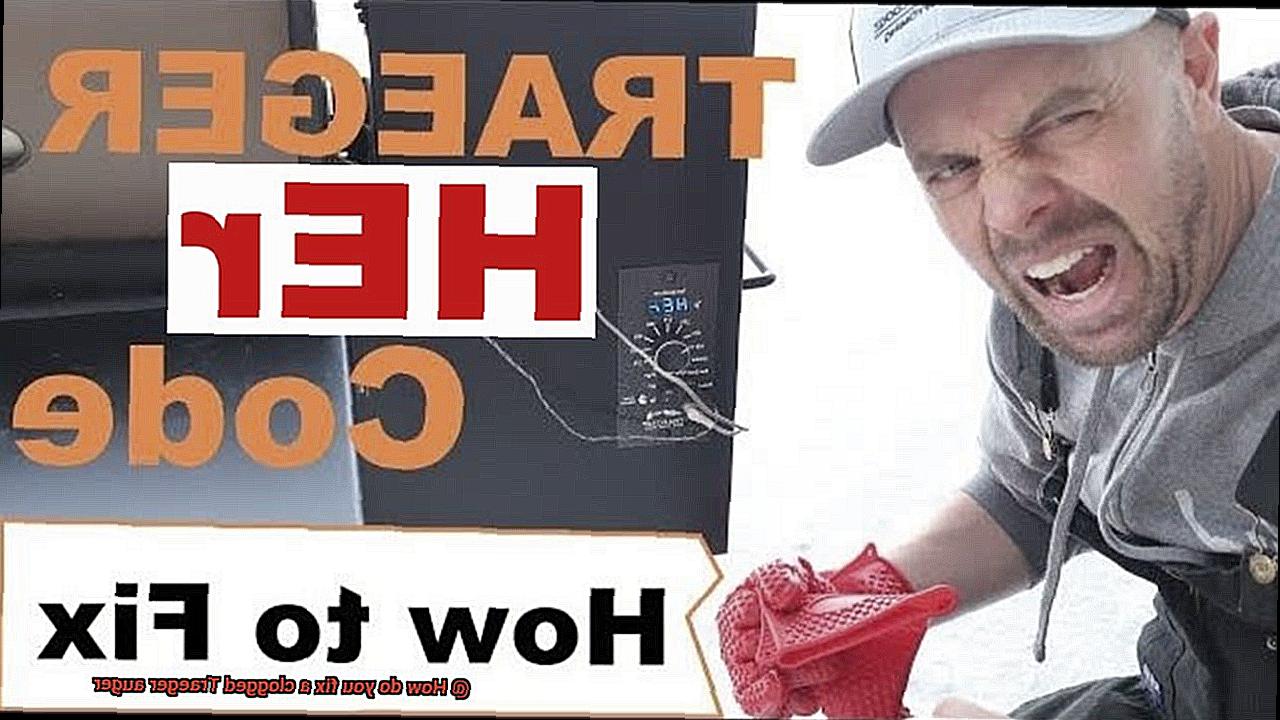
Now that you have access to the Traeger auger, you can proceed with cleaning or troubleshooting as needed. From checking for pellet jams to conducting routine maintenance, this step is essential for keeping your grill in top shape.
Step 4: Clear Out the Clog in the Auger
If you’ve made it to Step 4, it means you’re one step closer to fixing your clogged Traeger auger and getting back to grilling up a storm. In this step, we’ll dive into the nitty-gritty of clearing out the clog in your Traeger auger.
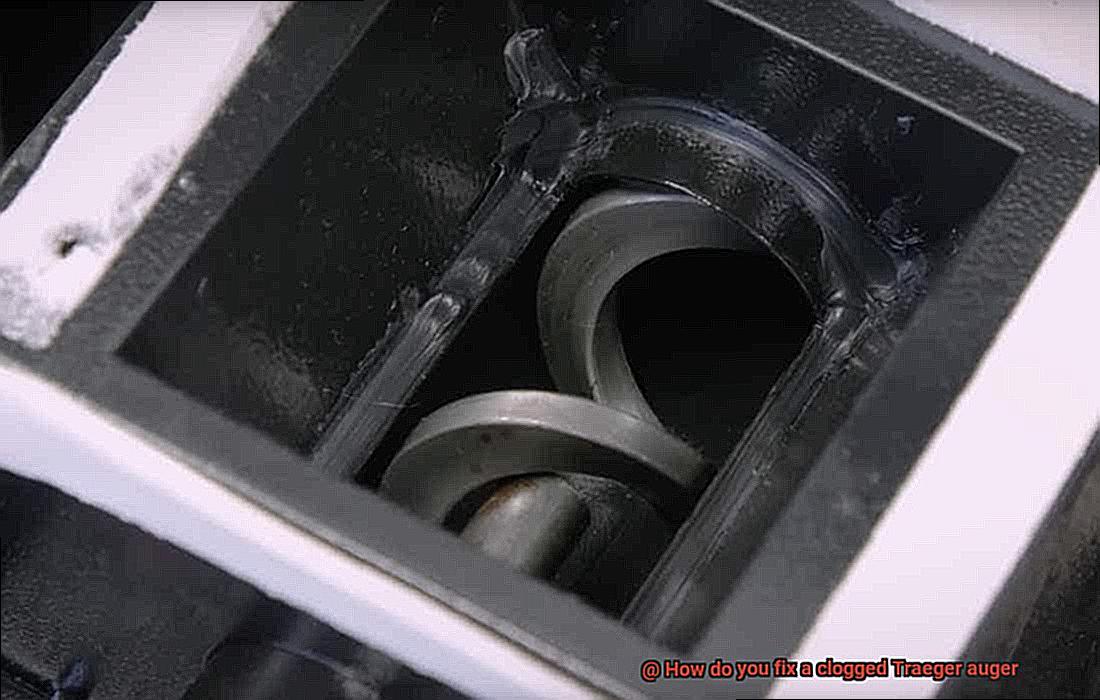
To get started, you’ll need to remove the auger from your grill and detach it from the motor. This will give you access to the inside of the auger tube where the pesky clog is causing trouble. Once you have the auger removed, grab a cleaning rod or a long object, like a coat hanger, and gently push out any debris that may be stuck in the auger tube.
It’s important to take your time during this step and be gentle while using the cleaning rod. The last thing you want to do is cause damage to your Traeger auger or grill. If the clog is proving to be particularly stubborn, don’t fret. You may need to disassemble the auger to fully clear it out.
Disassembling the auger involves removing the screws that hold it together and carefully taking it apart. Once disassembled, use a soft-bristled brush or cloth to clean any debris or buildup from each individual piece before reassembling the auger. Taking this extra step ensures that every piece is completely clear of debris before reattaching it to the motor and placing it back into your grill.
Now that you have successfully cleared out your Traeger auger clog, you can continue grilling up a storm. It’s important to remember that regular cleaning and maintenance can help prevent future clogs and keep your grill functioning at its best. Don’t forget to add these tasks to your routine maintenance checklist:
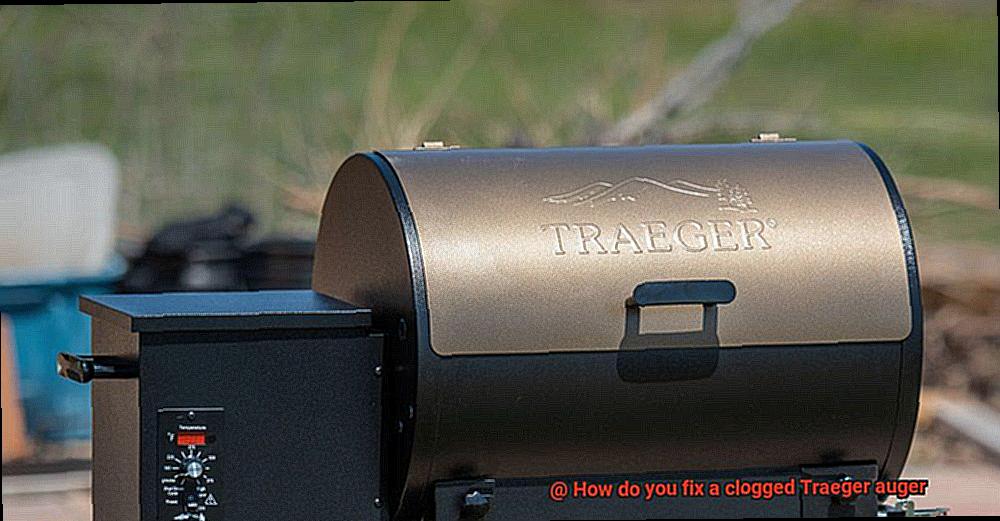
- Clean out the hopper regularly
- Check for any loose or damaged parts
- Inspect and clean the firepot and heat diffuser
Step 5: Disassemble the Auger if Necessary
So, you’ve followed our previous steps to unclog your Traeger auger, but the problem still persists. Fear not, as disassembling the auger might just be the solution.
Before we proceed, it is essential to highlight the importance of safety. Always unplug your grill and take necessary precautions before attempting any repairs or maintenance tasks. Now, let’s get started.
Firstly, remove the hopper from your grill and locate the auger motor. Depending on your grill model, you may need to remove other parts or screws to access the auger assembly. Once you have access to the auger assembly, carefully remove the auger from the motor shaft by turning it clockwise (remember Traeger augers are threaded in a reverse direction). Make sure to keep track of any washers or spacers that come off with the auger.
Now it’s time for some TLC for your auger. Inspect it thoroughly for any signs of damage or wear and give it a good cleaning with a brush or cloth. For those stubborn clogs, try using a wire brush or soaking it in warm soapy water to help break up the debris.
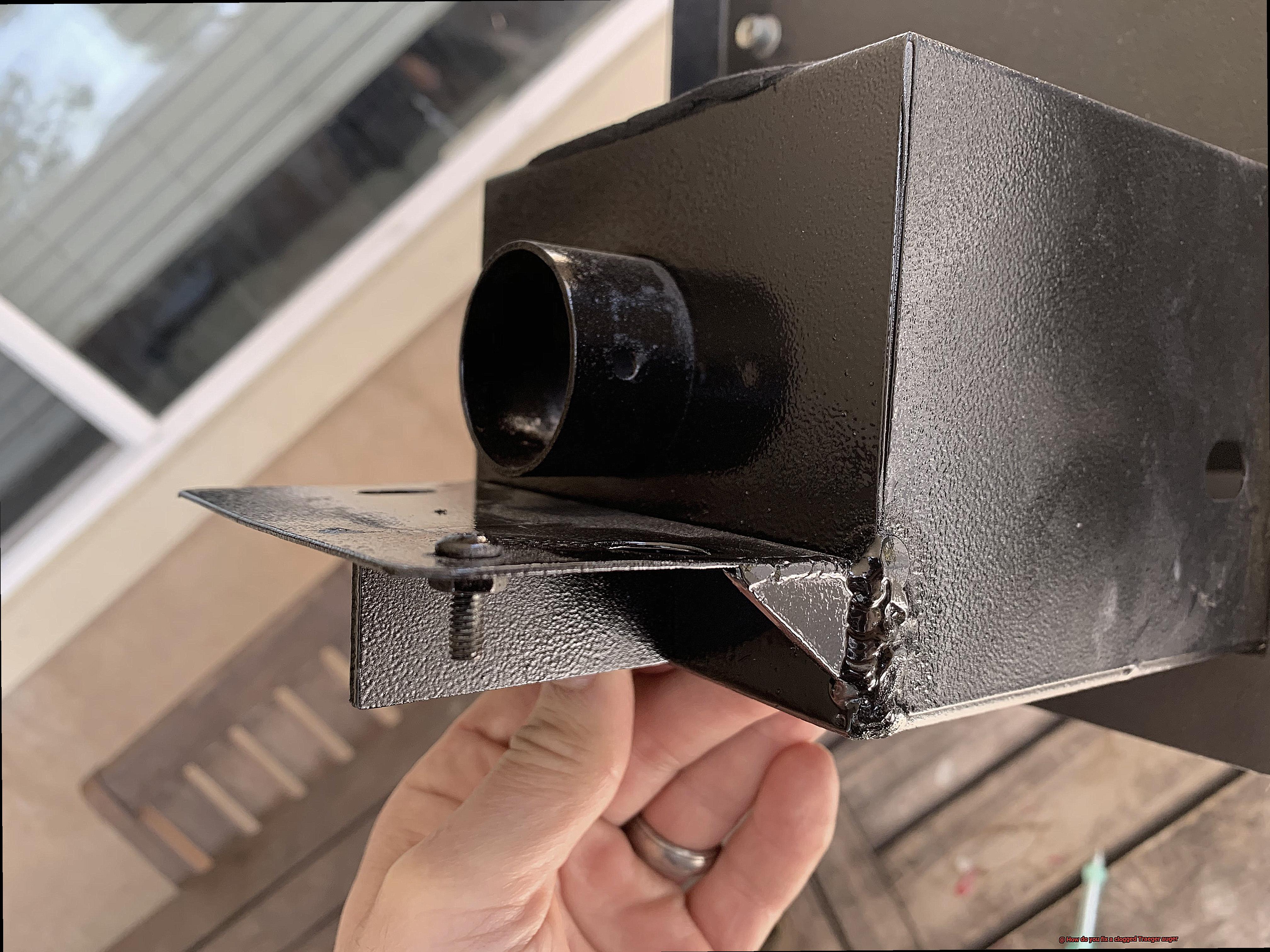
Here’s a quick summary of what you need to do:
- Unplug your grill and remove the hopper
- Locate the auger motor and remove it from the grill
- Remove other parts if necessary to access the auger assembly
- Carefully remove the auger from the motor shaft by turning it clockwise
- Inspect and clean the auger thoroughly
- Use a wire brush or soak it in warm soapy water for stubborn clogs
- Reassemble everything in reverse order, making sure all screws and bolts are tightened securely
Disassembling the Traeger auger may seem daunting at first, but with proper precautions and attention to detail, it can be done effortlessly. By taking the time to clean and inspect your auger thoroughly, you’ll ensure that your grill is running smoothly and producing mouth-watering meals for years to come.
RSlhvfsP9qI” >
Conclusion
In conclusion, a clogged Traeger auger can be a real headache for any grill enthusiast. But fear not. With the right tools and know-how, fixing it yourself is easier than you might think. The primary culprits of clogs are food debris, dirt, and moisture that accumulate in the auger over time. To prevent future blockages, make sure to store your pellets in a dry place away from any pesky moisture and inspect the auger regularly for any buildup.
If you do happen to experience a clog, follow our step-by-step guide to safely fix it yourself. Always prioritize safety by turning off and unplugging your grill before attempting any repairs or maintenance tasks. And if you’re not confident in your mechanical skills, seek professional help – better safe than sorry.
Regular cleaning and maintenance are key to preventing future clogs and keeping your grill functioning at its best. Don’t forget to add these tasks to your routine maintenance checklist: clean out the hopper regularly, check for any loose or damaged parts, and give the firepot and heat diffuser a good once-over.
With precise temperature control and unique smoky flavor imparted by wood pellets, Traeger Pellet Grills offer a wide range of temperatures that allow for precise cooking control.

